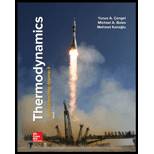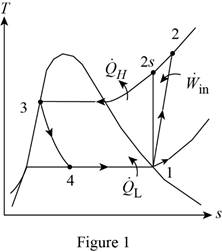
An air conditioner operates on the vapor-compression refrigeration cycle with refrigerant-134a as the refrigerant. The air conditioner is used to keep a space at 21°C while rejecting the waste heat to the ambient air at 37°C. The refrigerant enters the compressor at 180 kPa superheated by 2.7°C at a rate of 0.06 kg/s and leaves the compressor at 1200 kPa and 60°C. R-134a is subcooled by 6.3°C at the exit of the condenser. Determine (a) the rate of cooling provided to the space, in Btu/h, and the COP, (b) the isentropic efficiency and the exergy efficiency of the compressor, (c) the exergy destruction in each component of the cycle and the total exergy destruction in the cycle, and (d) the minimum power input and the second-law efficiency of the cycle.
(a)
The rate of cooling provided to the space.
The coefficient of performance of the air conditioner.
Answer to Problem 118RP
The rate of cooling provided to the space is
The coefficient of performance of the air conditioner is
Explanation of Solution
Show the T-s diagram as in Figure (1).

Express the refrigeration load.
Here, specific enthalpy at state 1 and 4 is
Express the rate of work input.
Express the coefficient of performance of the air conditioner.
Conclusion:
Perform the unit conversion of pressure at state 1 from
Refer to Table A-13, obtain the saturation temperature at a pressure of 0.18 MPa as
Calculate the temperature at state 1.
Substitute
Refer Table A-13, “superheated refrigerant-134a”, and write the properties corresponding to pressure and inlet temperature of
Here, specific enthalpy and entropy is
Write the formula of interpolation method of two variables.
Here, the variables denote by x and y is specific entropy at state 2 and specific enthalpy at state 2s respectively.
Show the specific enthalpy at state 2s corresponding to specific entropy by referring the table A-13 at pressure of 1.2 MPa and specific entropy of
|
Specific entropy at state 2 |
Specific enthalpy at state 2s |
| 0.9268 | 278.28 |
| 0.9484 | |
| 0.9615 | 289.66 |
Substitute the Table (1) values in Equation (IV) to get 285.34 kJ/kg.
Thus, the specific enthalpy at state 2s is,
Refer Table A-13, “superheated refrigerant-134a”, and write the properties corresponding to exit state of pressure and temperature of
Here, specific enthalpy and entropy at exit state are
Refer to Table A-13, obtain the saturation temperature at a pressure of 1.2 MPa as
Refer Table A-13, “superheated refrigerant-134a”, and write the properties corresponding to state 3 of pressure and temperature of
Here, specific enthalpy and entropy at state 3 are
Refer Table A-13, “superheated refrigerant-134a”, and write the properties corresponding to state 4 of pressure and specific enthalpy of
Substitute 0.06 kg/s for
Thus, the rate of cooling provided to the space is
Substitute 0.06 kg/s for
Substitute 2.670 kW for
Thus, the coefficient of performance of the air conditioner is
(b)
The isentropic efficiency of the compressor.
The exergy efficiency of the compressor.
Answer to Problem 118RP
The isentropic efficiency of the compressor is
The exergy efficiency of the compressor is
Explanation of Solution
Express the isentropic efficiency of the compressor.
Here, specific enthalpy at state 2s is
Calculate the reversible power for the compressor.
Here, ambient air temperature is
Calculate the exergy efficiency for the compressor.
Conclusion:
Substitute 285.34 kJ/kg for
Thus, the isentropic efficiency of the compressor is
Substitute 0.06 kg/s for
Substitute 2.428 kW for
Thus, the exergy efficiency of the compressor is
(c)
The exergy destruction in each component of the cycle.
The total exergy destruction in the cycle.
Answer to Problem 118RP
The exergy destruction in each component of the cycle are
The total exergy destruction in the cycle is
Explanation of Solution
Compressor
Express the entropy generation for cycle 1-2.
Express the exergy destruction for the cycle 1-2.
Condenser
Express the entropy generation for cycle 2-3.
Here, the rate of heat rejected is
Calculate the value of
Substitute
Express the exergy destruction for the cycle 2-3.
Expansion valve
Express the entropy generation for cycle 3-4.
Express the exergy destruction for the cycle 3-4.
Evaporator
Express the entropy generation for cycle 4-1.
Here, temperature at refrigeration load is
Express the exergy destruction for the cycle 4-1.
Calculate the total exergy destruction.
Conclusion:
Substitute 0.06 kg/s for
Substitute
Substitute 0.06 kg/s for
Substitute
Substitute 0.06 kg/s for
Substitute
Substitute 0.06 kg/s for
Substitute
Thus, the exergy destruction in each component of the cycle are
Substitute 0.2426 kW for
Thus, the total exergy destruction in the cycle is
(d)
The minimum power input of the cycle.
The second law efficiency of the cycle.
Answer to Problem 118RP
The minimum power input of the cycle is
The second law efficiency of the cycle is
Explanation of Solution
Express the exergy of the heat transferred from the low-temperature medium.
Here, minimum power input of the cycle is the exergy of the heat transferred from the low-temperature medium.
Calculate the second law efficiency of the cycle.
Calculate the total exergy destruction in the cycle.
Conclusion:
Substitute 8.213 kW for
Thus, the minimum power input to the cycle is
Substitute 0.4470 kW for
Thus, the second law efficiency of the cycle is
Want to see more full solutions like this?
Chapter 11 Solutions
Thermodynamics: An Engineering Approach
- PROBLEM 15.225 The bent rod shown rotates at the constant rate @₁ = 5 rad/s and collar C moves toward point B at a constant relative speed u = 39 in./s. Knowing that collar C is halfway between points B and D at the instant shown, determine its velocity and acceleration. Answers: v=-45 +36.6)-31.2 k in./s āc = -2911-270} in./s² 6 in 20.8 in. 14.4 in.arrow_forwardNeed help, please show all work, steps, units and please box out and round answers to 3 significant figures. Thank you!..arrow_forwardNeed help, please show all work, steps, units and please box out and round answers to 3 significant figures. Thank you!...arrow_forward
- FL y b C Z Determine the moment about O due to the force F shown, the magnitude of the force F = 76.0 lbs. Note: Pay attention to the axis. Values for dimensions on the figure are given in the following table. Note the figure may not be to scale. Variable Value a 1.90 ft b 2.80 ft с 2.60 ft d 2.30 ft Mo 144 ft-lb = -212 × 1 + xk) ☑+212arrow_forward20 in. PROBLEM 15.206 Rod AB is connected by ball-and-socket joints to collar A and to the 16-in.-diameter disk C. Knowing that disk C rotates counterclockwise at the constant rate ₁ =3 rad/s in the zx plane, determine the velocity of collar A for the position shown. 25 in. B 8 in. Answer: -30 in/s =arrow_forwardB Z 001 2.5 ft PROBLEM 15.236 The arm AB of length 16 ft is used to provide an elevated platform for construction workers. In the position shown, arm AB is being raised at the constant rate de/dt = 0.25 rad/s; simultaneously, the unit is being rotated about the Y axis at the constant rate ₁ =0.15 rad/s. Knowing that 20°, determine the velocity and acceleration of Point B. Answers: 1.371 +3.76)+1.88k ft/s a=1.22 -0.342)-0.410k ft/s² Xarrow_forward
- F1 3 5 4 P F2 F2 Ꮎ Ꮎ b P 3 4 5 F1 The electric pole is subject to the forces shown. Force F1 245 N and force F2 = 310 N with an angle = 20.2°. Determine the moment about point P of all forces. Take counterclockwise moments to be positive. = Values for dimensions on the figure are given in the following table. Note the figure may not be to scale. Variable Value a 2.50 m b 11.3 m C 13.0 m The moment about point P is 3,414 m. × N- If the moment about point P sums up to be zero. Determine the distance c while all other values remained the same. 1.26 m.arrow_forwardZ 0.2 m B PROBLEM 15.224 Rod AB is welded to the 0.3-m-radius plate, which rotates at the constant rate ₁ = 6 rad/s. Knowing that collar D moves toward end B of the rod at a constant speed u = 1.3 m, determine, for the position shown, (a) the velocity of D, (b) the acceleration of D. Answers: 1.2 +0.5-1.2k m/s a=-7.21-14.4k m/s² A 0.25 m 0.3 marrow_forwardI am trying to code in MATLAB the equations of motion for malankovich orbitlal elements. But, I am having a problem with the B matrix. Since f matrix is 7x1 and a_d matrix has to be 3x1, the B matrix has to be 7x3. I don't know how that is possible. Can you break down the B matrix for me and let me know what size it is?arrow_forward
- I am trying to code the solution to the problem in the image in MATLAB. I wanted to know what is the milankovich constraint equation that is talked about in part b.arrow_forwardmylabmastering.pearson.com Chapter 12 - Lecture Notes.pptx: (MAE 272-01) (SP25) DY... P Pearson MyLab and Mastering Scoresarrow_forwardAir modeled as an ideal gas enters an insulated compressor at a temperature of 300 K and 100 kPa, and leaves at 600 kPa. The mass flowrate of air entering the compressor is 50 kg/hr, and the power consumed by the compressor is 3 kW. (Rair = 0.287 kJ/kg-K, k = 1.4, cp = 1.0045 kJ/kg-K, cv = 0.718 kJ/kg-K) Determine the isentropic exit temperature (Te,s) of the air in [K]. Determine the actual exit temperature (Te) of the air in [K]. Determine the isentropic efficiency of the compressor. (Answer: ηc,s = 93.3%) Determine the rate of entropy generated through the compressor in [kW/K]. (Answer: Ṡgen = 0.000397 kW/K)arrow_forwardarrow_back_iosSEE MORE QUESTIONSarrow_forward_ios
 Refrigeration and Air Conditioning Technology (Mi...Mechanical EngineeringISBN:9781305578296Author:John Tomczyk, Eugene Silberstein, Bill Whitman, Bill JohnsonPublisher:Cengage Learning
Refrigeration and Air Conditioning Technology (Mi...Mechanical EngineeringISBN:9781305578296Author:John Tomczyk, Eugene Silberstein, Bill Whitman, Bill JohnsonPublisher:Cengage Learning
